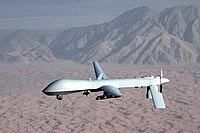
Photo from wikipedia
The use of a remote-controlled drone system (RDS) by eye movements was studied to assist patients in psychiatric long-term care (PLTC) to allow them to view the environment outside the… Click to show full abstract
The use of a remote-controlled drone system (RDS) by eye movements was studied to assist patients in psychiatric long-term care (PLTC) to allow them to view the environment outside the hospital, hoping that this will bring them some enjoyment. However, successfully applying this system requires human intermediaries in facilitating the interactions between patients and RDS operators. The aim of the study was to describe the role of nurses as intermediaries in the application of an RDS through eye movements of patients PLTC. This study employed the Intentional Observational Clinical Research Design. Data collection was performed in November 2021 at a psychiatric hospital with selected patients in PLTC. Seventeen patients took part in the indoor experiment, whereas 23 patients took part in the outdoor experiment. Fifteen of the 23 patients in the outdoor experiment were the same patients who took part in the indoor experiment. Most of the patients in the indoor and outdoor test arenas could successfully, delightfully, and safely fly the drone. This study demonstrated that RDS using just eye movements could increase the quality of life in older patients with psychiatric problems in PLTC. For the successful use of this drone system, nurse intermediaries assumed critically significant roles.
Journal Title: Healthcare
Year Published: 2022
Link to full text (if available)
Share on Social Media: Sign Up to like & get
recommendations!